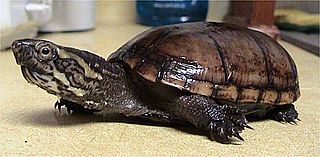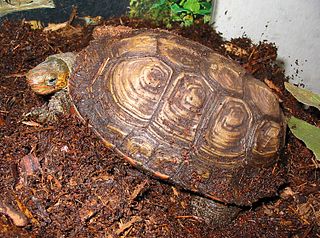
The Kinosternidae are a family of mostly small turtles that includes the mud turtles and musk turtles. The family contains 25 species within four genera, but taxonomic reclassification is an ongoing process, so many sources vary on the exact numbers of species and subspecies. They inhabit slow-moving bodies of water, often with soft, muddy bottoms and abundant vegetation.

Macrochelys is a genus of very large freshwater turtles in the family Chelydridae, native to the Southeastern and Midwestern United States. Only a single extant species was recognized until 2014, when a study divided it into two, or possibly three species. These turtles are easily recognized by three distinct dorsal ridges with raised spikes.

Kinosternon is a genus of small aquatic turtles from the Americas known commonly as mud turtles.

Sternotherus is a genus of turtles in the family Kinosternidae including six species commonly known as musk turtles. The genus is endemic to North America, occurring in the eastern third of the US and southeast Ontario, Canada. Musk glands positioned near the bridge of the shell can produce foul smelling secretions when the turtles are threatened, although gentle handling does not normally provoke a response. Sternotherus are moderately small turtles, with the largest species in the genus, the razor-backed musk turtle, attaining a maximum of 17.6 cm. in shell length. The carapace is characteristically oval and domed, with most species having one or three keels on the back which may become smoother and obscure with age in some species. Musk turtles are generally drab in color, mostly black, gray, brown, olive, or ocher, which aid in camouflaging them in their natural habitats. The head is relatively large and stout, marked with spots, streaks, or strips. The plastron has only 10 or 11 scutes, as opposed to 12, a more common condition in North American turtles. The tail is short, with males having a horny claw like tip.

The yellow mud turtle, also commonly known as the yellow-necked mud turtle, is a species of mud turtle in the family Kinosternidae. The species is endemic to the Central United States and Mexico.

Rhinoclemmys is a genus of turtles in the family Geoemydidae, the only genus in the subfamily Rhinoclemmydinae. Member species of the genus are commonly known as the Neotropical wood turtles and are the only geoemydids known from the Americas. As such, they have adapted to a wide range of habitats, which is reflected in the species' common names.

Hesperotestudo is an extinct genus of tortoise native to North and Central America from the Early Miocene to the Late Pleistocene. Species of Hesperotestudo varied widely in size, with a large undescribed specimen from the Late Pleistocene of El Salvador reaching 150 cm (4.9 ft) in carapace length, larger than that of extant giant tortoises. Historically considered a subgenus of Geochelone, it is now considered to be distantly related to that genus. Its relationships with other tortoises are uncertain. The exposed areas of the bodies of Hesperotestudo species were extensively covered with large dermal ossicles, which in life were covered in keratin. It has been suggested that species of Hesperotestudo were relatively tolerant of cold weather. Hesperotestudo became extinct at the end of the Pleistocene roughly co-incident with the arrival of the first humans in North America. There is apparently a site in Florida where one individual may have been killed that some suggested were evidence of butchering, although others suggested that the turtle was neither cooked nor does a ledge that was found near it date at the same time as it.
Syllomus is an extinct genus of sea turtle from the Miocene-age deposits in the US Eastern Seaboard and Egypt.

Allaeochelys is an extinct genus of Carettochelyid turtle, known from the Eocene to Miocene of Europe, Asia, North America and Africa.

Chelonoidis is a genus of turtles in the tortoise family erected by Leopold Fitzinger in 1835. They are found in South America and the Galápagos Islands, and formerly had a wide distribution in the West Indies.
Kinosternon arizonense is an extinct species of mud turtle in the genus Kinosternon. Initially described by Charles W. Gilmore in 1922. In 2016 McCord examined available Pliocene material of K. arizonense and concluded that the fossil material differs significantly from the extant turtles. Joyce and Bourque (2016) concurred. Rhodin et al. (2017), listed Kinosternon arizonense as extinct.

The rough-footed mud turtle is a species of mud turtle in the family Kinosternidae. The species is endemic to the southwestern United States and northern Mexico.

The Mexican mud turtle, is a species of mud turtle in the family Kinosternidae. Endemic to Mexico, it is found in Aguascalientes, Colima, Durango, Guanajuato, Guerrero, Hidalgo, Jalisco, Michoacán, México, Morelos, Nayarit, Oaxaca, Puebla, Queretaro, San Luis Potosí, Sinaloa, Sonora, Tamaulipas and Zacatecas, where they inhabit moist environments, such as shallow ponds, lakes, rivers or intermediate temp. tropical forest areas.

Megalochelys is an extinct genus of tortoises that lived from the Miocene to Pleistocene. They are noted for their giant size, which is among the largest of any known testudine, with a maximum carapace length over 2 m (6.5 ft) in M. atlas. During the dry glacial periods it ranged from western India and Pakistan to as far east as Sulawesi and Timor in Indonesia, though the island specimens likely represent distinct species.

The Ash Hollow Formation of the Ogallala Group is a geological formation found in Nebraska and South Dakota. It preserves fossils dating back to the Neogene period. It was named after Ash Hollow, Nebraska and can be seen in Ash Hollow State Historical Park. Ashfall Fossil Beds State Historical Park is within this formation.

The Tesuque Formation is a geologic formation in north-central New Mexico, United States. The formation provides an unusually complete record of the evolution of mammals during the Miocene epoch.

The Tenerife giant tortoise is an extinct species of cryptodire turtle in the family Testudinidae endemic to the island of Tenerife, in the Canary Islands.
The Gran Canaria giant tortoise is an extinct species of cryptodire turtle in the family Testudinidae endemic to the island of Gran Canaria, in the Canary Islands.
Rhinoclemmys panamaensis is an extinct species of turtle belonging to the genus Rhinoclemmys of the family Geoemydidae known from the early to middle Miocene (Hemingfordian) Cucaracha Formation of the Panama Basin of central Panama.
Phrynops paranaensis is an extinct species of turtle from the Huayquerian Ituzaingó Formation of the Paraná Basin, Argentina, likely to be late Miocene in origin.













